 W
WThe Klondike Gold Rush was a migration by an estimated 100,000 prospectors to the Klondike region of the Yukon, in north-western Canada, between 1896 and 1899. Gold was discovered there by local miners on August 16, 1896; when news reached Seattle and San Francisco the following year, it triggered a stampede of prospectors. Some became wealthy, but the majority went in vain. It has been immortalized in films, literature, and photographs.
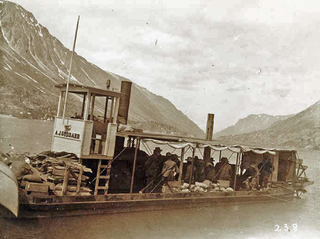 W
WA. J. Goddard was a Klondike Gold Rush era sternwheeler owned by Seattle businessman Albert J. Goddard and built for transport of men and supplies on the Upper Yukon River in Canada. She was assembled from pieces which were manufactured in San Francisco, shipped up to Skagway, Alaska, hauled over the Coast Mountains, and finally assembled at Lake Bennett. She made one trip to Dawson during the gold rush, was sold and sank in a storm on Lake Laberge in 1901. Her wreck was discovered in 2008 by Doug Davidge and was designated as a Yukon Historic Site.
 W
WBennett Lake is a lake in the Province of British Columbia and Yukon Territory in northwestern Canada. It is just north of the border with the United States state of Alaska, near the Alaskan port of Skagway.
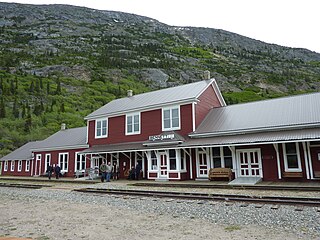 W
WBennett, British Columbia, Canada, is an abandoned town next to Bennett Lake and along Lindeman Creek. The townsite is now part of the Chilkoot Trail National Historic Site of Canada and is managed by Parks Canada. Bennett is also a stop on the White Pass and Yukon Route Railroad during the summer months.
 W
WBonanza Creek is a watercourse in Yukon Territory, Canada. It runs for about 20 miles (32 km) from King Solomon's Dome to the Klondike River. In the last years of the 19th century and the early 20th century, Bonanza Creek was the centre of the Klondike Gold Rush, which attracted tens of thousands of prospectors to the creek and the area surrounding it. Prior to 1896 the creek was known as Rabbit Creek. Its name was changed by miners in honour of the millions of dollars in gold found in and around the creek.
 W
WBurning Daylight is a novel by Jack London, published in 1910, which was one of the best-selling books of that year and it was London's best-selling book in his lifetime. The novel takes place in the Yukon Territory in 1893. The main character, nicknamed "Burning Daylight" was the most successful entrepreneur of the Alaskan Gold Rush. The story of the main character was partially based upon the life of Oakland entrepreneur "Borax" Smith. The novel was subsequently filmed as a First National movie starring Milton Sills with Doris Kenyon.
 W
WThe Chechahcos is a 1924 American silent adventure drama film about the gold rush days in the Klondike. Chechahco, more commonly spelled cheechako, is a Chinook Jargon word for "newcomer", and the film focuses on a group of would-be prospectors sailing for Alaska. The film was directed by Lewis H. Moomaw and produced by Austin E. Lathrop, who himself was once a prospector. The film was distributed by Associated Exhibitors.
 W
WThe Chilkat Pass is a mountain pass on the border of Alaska, United States, and the province of British Columbia, Canada, at the divide between the Klehini (S) and Kelsall Rivers just northwest of Haines, Alaska. At an elevation of 3510 ft, it is used by the Haines Highway and was the route used by the Dalton Trail during the days of the Klondike Gold Rush. It also marks the boundary between the Coast Mountains and Saint Elias Mountains.
 W
WChilkoot Pass is a high mountain pass through the Boundary Ranges of the Coast Mountains in the U.S. state of Alaska and British Columbia, Canada. It is the highest point along the Chilkoot Trail that leads from Dyea, Alaska to Bennett Lake, British Columbia. The Chilkoot Trail was long a route used by the Tlingit for trade.
 W
WThe Chilkoot Trail is a 33-mile (53 km) trail through the Coast Mountains that leads from Dyea, Alaska, in the United States, to Bennett, British Columbia, in Canada.
 W
WThe Chilkoot Trail tramways were aerial tramways that played a significant role in the Klondike Gold Rush and the Chilkoot Trail as a transportation system to move prospectors and equipment towards the Dawson City/Klondike gold fields.
 W
WThe Copperbelt Railway & Mining Museum (CR&MM) is run by the Miles Canyon Historic Railway Society (MCHRS), which consists of a board of six members. The objectives of the society are to: a) To preserve, promote and to protect the railway heritage of the Yukon; b) To develop and operate the Waterfront Trolley; c) To develop and operate the Copperbelt Railway & Mining Museum; and d) To promote and enhance tourism development in the city of Whitehorse and the Yukon.
 W
WThe Dalton Trail is a trail that runs between Pyramid Harbor, west of Haines, Alaska in the United States, and Fort Selkirk, in the Yukon Territory of Canada, using the Chilkat Pass. It is 396 km (246 mi) long.
 W
WDawson City, officially the Town of the City of Dawson, is a town in the Canadian territory of Yukon. It is inseparably linked to the Klondike Gold Rush (1896–99). Its population was 1,375 as of the 2016 census, making it the second largest town of Yukon.
 W
WDiscovery Claim is a mining claim at Bonanza Creek, a watercourse in the Yukon, Canada. It is the site where, in the afternoon of August 16, 1896, the first piece of gold was found in the Yukon by prospectors. The site is considered to be the place where the Klondike gold rush started. It is located around 17 km south-southeast of Dawson City. The Discovery claim was designated a National Historic Site of Canada on July 13, 1998.
 W
WDyea is a former town in the U.S. state of Alaska. A few people live on individual small homesteads in the valley; however, it is largely abandoned. It is located at the convergence of the Taiya River and Taiya Inlet on the south side of the Chilkoot Pass within the limits of the Municipality of Skagway Borough, Alaska. During the Klondike Gold Rush prospectors disembarked at its port and used the Chilkoot Trail, a Tlingit trade route over the Coast Mountains, to begin their journey to the gold fields around Dawson City, Yukon, about 800 km (500 mi) away. Confidence man and crime boss Soapy Smith, famous for his underworld control of the neighboring town of Skagway in 1897–98 is believed to have had control of Dyea as well.
 W
WFort Selkirk is a former trading post on the Yukon River at the confluence of the Pelly River in Canada's Yukon. For many years it was home to the Selkirk First Nation.
 W
WForty Mile is best known as the oldest town in Canada’s Yukon. It was established in 1886 at the confluence of the Yukon and Fortymile rivers by prospectors and fortune hunters in search of gold. Largely abandoned during the nearby Klondike Gold Rush, the town site continued to be used by Tr’ondëk Hwëch’in. It is currently a historic site that is co-owned and co-managed by Tr’ondëk Hwëch’in and the Government of Yukon.
 W
WFraser is a location on the Klondike Highway in northwestern British Columbia, Canada.
 W
WGlacier Camp is an uninhabited locality in far northwestern British Columbia, Canada, located on the route of the Haines Highway and the Dalton Trail. During the Klondike Gold Rush, it was a major boomtown-staging ground for travellers bound from Haines, Alaska to the Yukon and also was a mining camp itself. Abandoned today though a few ruins are extant, it is located west of Bennett, British Columbia near the confluence of Mule and Nadahini Creeks. Forming a pass between the basins of the Tatshenshini and Kelsall Rivers, it forms the prominence col for the Devils Paw, a summit in the Boundary Ranges.
 W
WThe Grand Forks Hotel was a prominent roadhouse during the Klondike Gold Rush, situated near Dawson City in the Yukon region of Canada.
 W
WThe Shootout on Juneau Wharf was a gunfight between Jefferson Randolph "Soapy" Smith, Frank H. Reid, and Jesse Murphy that took place on Friday, July 8, 1898, at approximately 9:15 p.m. in Skagway, District of Alaska, in the United States. Smith was shot in the heart and died shortly afterwards, and Reid died of his injuries 12 days later.
 W
WKeish, legally James Mason, best known by his nickname Skookum Jim Mason, was a member of the Tagish First Nation in what became the Yukon Territory of Canada. He was born near Bennett Lake on what is now the British Columbia and Yukon border, to a Tahltan woman. He lived in Caribou Crossing, now Carcross, Yukon, Canada.
 W
WKing Solomon's Dome, also called King Solomon Dome, is a 1,234-metre (4,049 ft) peak in the Yukon-Mackenzie Divide region of the Yukon Territory, Canada. It is 32 kilometres (20 mi) southeast of Dawson City, Yukon, and is believed to be the source of the gold fields that sparked the Klondike Gold Rush at the turn of the 20th century. The mountain's name comes from King Solomon, an ancient king of Israel who was famed for his riches.
 W
WKlondike City was a Klondike gold rush era settlement on the outskirts of Dawson City in the Yukon Territory. It was renowned for prostitution. The area is mentioned in Jack London's novel White Fang. O'Brien Brewing and Malting Company was located in Klondike City. It was majority owned Thomas W. O’Brien who was also a landowner.
 W
WKlondike Gold Rush National Historical Park is a national historical park operated by the National Park Service that seeks to commemorate the Klondike Gold Rush of the late 1890s. Though the gold fields that were the ultimate goal of the stampeders lay in the Yukon Territory, the park comprises staging areas for the trek there and the routes leading in its direction. There are four units, including three in Municipality of Skagway Borough, Alaska and a fourth in the Pioneer Square National Historic District in Seattle, Washington.
 W
WThe Klondike Mines Railway (KMRy) was a 3 ft narrow gauge railway operating in the Klondike region of Yukon, Canada. Construction on the KMRy began in 1905 and the railway ceased operations in 1913.
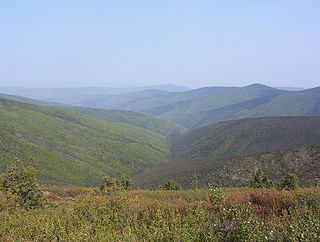 W
WThe Klondike is a region of the Yukon territory in northwest Canada, east of the Alaskan border. It lies around the Klondike River, a small river that enters the Yukon River from the east at Dawson City.
 W
WLake Laberge is a widening of the Yukon River north of Whitehorse, Yukon in Canada. It is fifty kilometres long and ranges from two to five kilometres wide. Its water is always very cold, and its weather often harsh and suddenly variable.
 W
WLindeman Lake, also known as Lake Lindeman, is a lake on the Chilkoot Trail in far northwestern British Columbia, Canada. It is just south of Bennett Lake and northeast of the summit of the Chilkoot Pass. From the direction of the pass it is fed by Lindeman Creek, which connects the two lakes. Lake Lindeman and Lake Bennett were key components of the Chilkoot Trail during the Klondike Gold Rush, with both seeing hundreds of vessels built to transit their waters and camp-town "tent cities" established on their shores. Lindeman was located at the south end of Lindeman Lake, while Bennett, often known as Bennett City, was at the south end of Lake Bennett.
 W
W W
WThe Nome Gold Rush was a gold rush in Nome, Alaska, approximately 1899–1909. It is separated from other gold rushes by the ease with which gold could be obtained. Much of the gold was lying in the beach sand of the landing place and could be recovered without any need for a claim. Nome was a sea port without a harbor, and the biggest town in Alaska.
 W
WNome is a city in the Nome Census Area in the Unorganized Borough of Alaska, United States. The city is located on the southern Seward Peninsula coast on Norton Sound of the Bering Sea. In 2018 the population was estimated at 3,866, a rise from the 3,598 recorded in the 2010 Census, up from 3,505 in 2000. Nome was incorporated on April 9, 1901, and was once the most-populous city in Alaska. Nome lies within the region of the Bering Straits Native Corporation, which is headquartered in Nome.
 W
WThe North-West Mounted Police (NWMP) was a Canadian police force, established in 1873 by the Prime Minister, Sir John Macdonald, to maintain order in the North-West Territories. The mounted police combined military, police and judicial functions along similar lines to the Royal Irish Constabulary, and deployed the following year to the Alberta border in response to the Cypress Hills Massacre and subsequent fears of a United States military intervention. Their ill-planned and arduous journey of nearly 900 miles (1,400 km) became known as the March West and was portrayed by the force as an epic journey of endurance. Over the next few years, the police extended Canadian law across the region, establishing good working relationships with the First Nations. The force formed part of the military response to the North-West Rebellion in 1885, but faced criticism for their performance during the conflict.
 W
WPleasant Camp, also known as the Dalton Trail Camp, is a historic frontier police outpost near Haines, Alaska. It was established by the Canadian Northwest Mounted Police in 1898 as a border station between the United States and Canada where they could control the flow of miners during the Klondike Gold Rush. It is located at Mile 40 of the Haines Highway. The post was operated by the NWP until roughly 1899. The border between the two countries was formalized in the area in 1900, resulting in the presence of this former Canadian outpost on US soil.
 W
WPortus B. Weare was a wooden sternwheel steamship built in 1892 for service on the Yukon River. She played a notable role in the Klondike gold rush, being the second ship to bring news of the Klondike gold strike and an estimated $1 million in gold down the river in 1897. This set off the gold rush. The vessel carried freight and passengers up the Yukon to Dawson City and later Fairbanks. She was abandoned in 1926 or 1927, after the need for steamboat transport to the interior declined.
 W
WSS Princess Sophia was a steel-built passenger liner in the coastal service fleet of the Canadian Pacific Railway (CPR). Along with SS Princess Adelaide, SS Princess Alice, and SS Princess Mary, Princess Sophia was one of four similar ships built for CPR during 1910-1911.
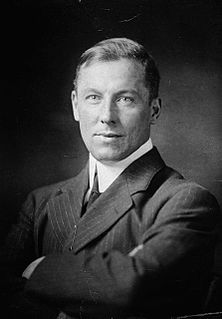 W
WRobert William Service was a British-Canadian poet and writer, often called "the Bard of the Yukon".
 W
WThe Municipality and Borough of Skagway is a first-class borough in Alaska on the Alaska Panhandle. As of the 2010 census, the population was 968. Estimates put the 2019 population at 1,183 people. The population doubles in the summer tourist season in order to deal with more than 1,000,000 visitors each year. Incorporated as a borough on June 25, 2007, it was previously a city in the Skagway-Yakutat-Angoon Census Area.
 W
WTaiya Inlet is part of the upper Lynn Canal located in the U.S. state of Alaska. Taiya Inlet is an estuary which lies in a deep valley, with Skagway, Alaska at its north end and the remainder of the Lynn Canal at its south end.
 W
WThe Taiya River is a 17-mile-long (27 km) river in the U.S. state of Alaska running from the border with British Columbia, Canada, to the Taiya Inlet of upper Lynn Canal.
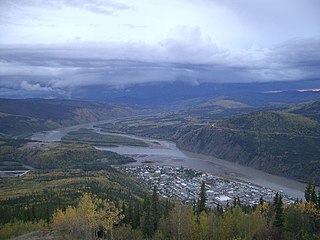 W
WTr'ochëk is the site of a traditional Han fishing camp at the confluence of the Klondike River and Yukon River. The site is owned and managed by the Tr’ondëk Hwëch’in First Nation, and is operated by the First Nation's Department of Heritage.
 W
WWhite Fang is a novel by American author Jack London (1876–1916) — and the name of the book's eponymous character, a wild wolfdog. First serialized in Outing magazine, it was published in 1906. The story details White Fang's journey to domestication in Yukon Territory and the Northwest Territories during the 1890s Klondike Gold Rush. It is a companion novel to London's best-known work, The Call of the Wild (1903), which is about a kidnapped, domesticated dog embracing his wild ancestry to survive and thrive in the wild.
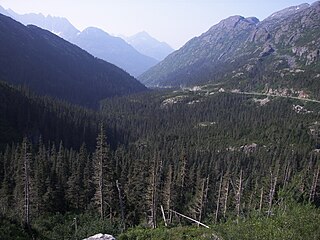 W
WWhite Pass, also known as the Dead Horse Trail, is a mountain pass through the Boundary Ranges of the Coast Mountains on the border of the U.S. state of Alaska and the province of British Columbia, Canada. It leads from Skagway, Alaska, to the chain of lakes at the headwaters of the Yukon River, Crater Lake, Lake Lindeman, and Bennett Lake.
 W
WThe White Pass and Yukon Route is a Canadian and U.S. Class II 3 ft narrow-gauge railroad linking the port of Skagway, Alaska, with Whitehorse, the capital of Yukon. An isolated system, it has no direct connection to any other railroad. Equipment, freight and passengers are ferried by ship through the Port of Skagway, and via road through a few of the stops along its route.
 W
WThe Yukon Field Force, later termed the Yukon Garrison, was a unit of 203 officers and men from the Permanent Force of the Canadian Militia that served in the Yukon between 1898 and 1900. The force was created in the wake of the Klondike Gold Rush in response to fears that the United States might attempt to seize the region. It left Ottawa on May 6 1898, travelling by rail and sea to the port of Glenora in British Columbia. From there, the unit made an arduous journey of 890 kilometres (550 mi) on foot and using makeshift boats to Fort Selkirk, where they established their headquarters. A detachment of 72 men was sent to the boom town of Dawson City to support the North West Mounted Police, with duties that included guarding the gold deposits of the local banks. As the fears of an annexation reduced, pressures grew for the recall of the force. The force was halved in size in July 1898 and the remainder were finally withdrawn in June 1900.
 W
WThe Yukon Hotel is a National Historic Site of Canada and part of the Dawson Historical Complex. It is a log building with a three-storey false facade on First Avenue at the corner of Church Street in Dawson City, Yukon.
 W
WThe Yukon Order of Pioneers is a fraternal order founded on December 1, 1894 at Forty Mile, Yukon for the purposes of establishing a police force and a fraternal group whose primary concern would be the welfare, security and well-being of its members. Membership was restricted to male persons of integrity and good character who met a ten year residency requirement. By the early 1900s, the policing activities of the Order were no longer required, and since that time the Order's primary objectives have been social, historical and cultural, with its paramount concern being the welfare and well-being of its members. There are presently two lodges, #1 in Dawson City and #2 in Whitehorse.